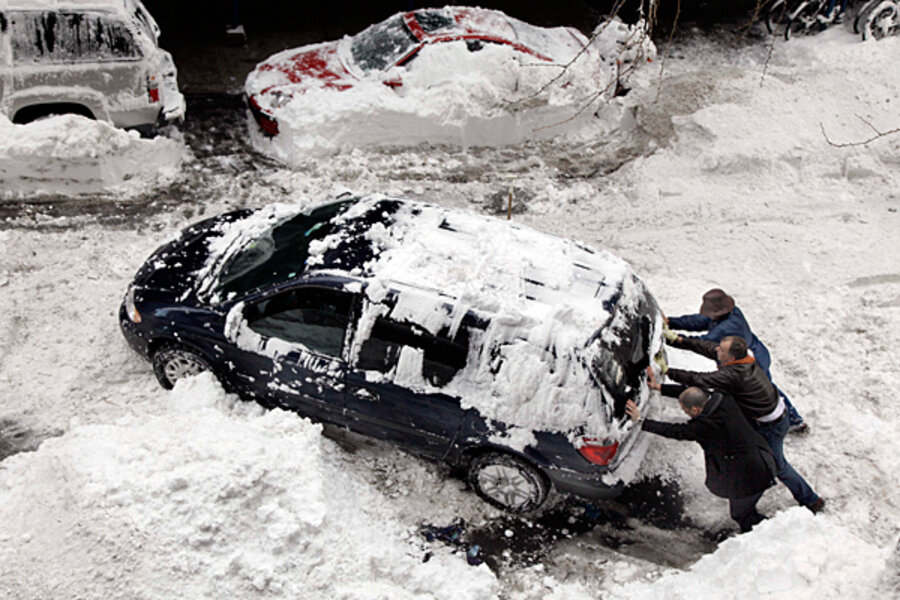Monster storm? Mountains of snow? We've seen this movie.
Loading...
| New York
For a lot of people living in the Northeast, it feels like Groundhog Day – the movie.
A bad snow storm – make that a near-blizzard – pelts the area with a foot or more of the white stuff. Public transportation grinds to a halt. Crossing a street becomes a mountain-climbing experience. And, guess what? Just like in the movie, you get to wake up and do it all over again.
On Thursday morning, the snow statistics sound vaguely like the late December blizzard that brought places like New York City, Long Island, and Connecticut to their knees: Central Park got 19 inches of snow; Bridgeport, Conn., more than 12 inches; Boston 11 inches.
What are the top 5 snow storms of the decade?
In New York, the January snowfall total has now reached 36 inches, breaking a record set in 1925. Some meteorologist expect New York will break the prior record of 75.6 inches set in the winter of 1995-1996.
The cycle of snow might not be so bad if some of it had melted. But in places like Boston, residents are now wondering where to move it. So far this season, the city has received 60.3 inches of snow, more than three times the average for this date, 18.8 inches, and almost 50 percent more than the average total for the entire winter, 41.8 inches.
“It’s piled everywhere,” says Amy Staley, a resident of Somerville, Mass., adjacent to Boston. “I am a social worker and have to drive to people’s houses, so you have to get out and dig a place out to find a parking space.”
The snow is piled so high, Ms. Staley says, it has become difficult to see around the corners at intersections. “You are definitely inching your way out and thinking, 'I haven’t seen anyone so maybe I’ll go a little bit further.' ”
Like the December storm, the storm overnight caused massive transportation problems. Amtrak canceled its service between New York and Boston. Airlines operating out of Northeast airports in Philadelphia, New York, and Boston canceled scores of flights. New York’s Metropolitan Transportation Authority pulled its buses off the streets and the limited subway service was packed.
School calendars in peril
And school calendars in the Boston area are suddenly being threatened, too. Boston Public Schools have now used up four of their five budgeted snow days. Any more, and the children’s joy at missing school for snow could turn to anguish when the school year is extended in late June. Some school districts say they may even (gasp) weigh the cancellation of some vacation days if the midweek storms don’t let up.
In New York, Mayor Michael Bloomberg asked New Yorkers not to drive to work so they would not get stuck in the streets, as happened in the last major storm. “If you get stuck, your car will be towed at your own expense, and you will also prevent us from plowing,” Mr. Bloomberg said at a Thursday morning press conference.
The city also canceled school, a rarity. The mayor, making it sound as if he’s fighting a war, says the city will do a post-mortem to see how it did in this storm to see if it can do better next time.
Next time is going to come sooner rather than later. Another smaller storm will arrive over the weekend, dumping no more than a few inches, says Henry Margusity, Accu-Weather.com meteorologist and severe weather expert in State College, Pa.
But next week there might be two more storms, says Mr. Margusity. “It’s not all clear-cut, there are some diversity in the computer models,” he says, noting the models themselves have been “horrendous” this winter.
La Niña is 'so darn strong'
He believes one reasons weather forecasters have had difficulty this winter is because the La Niña current, a cold current in the Pacific Ocean, has been “so darn strong, the strongest in decades.”
Margusity notes that sometimes weather can get stuck in a pattern that becomes hard to change. That seems to be the case this year, when waves of Arctic cold have buffeted the region, followed by storms running up the coast. An area of high pressure over Greenland is preventing the storms from moving out to sea, as they often do.
Next Wednesday is Groundhog Day, when cities around the nation pull the rodents out of their lairs – the most famous of them Phil, in Punxsutawney, Pa. – to see how much longer winter will last. If the groundhog sees his shadow, supposedly there will be six more weeks of winter.
Accu-Weather will save Phil the effort: The cold is expected to last at least through the middle of February. In fact, Accu-weather plans to use Groundhog Day to issue a forecast that no one, except snow plow operators, will like: “We think the cold is going to stick around for a few more years,” says the forecaster. “Winters like this are a sign of winters to come.”





